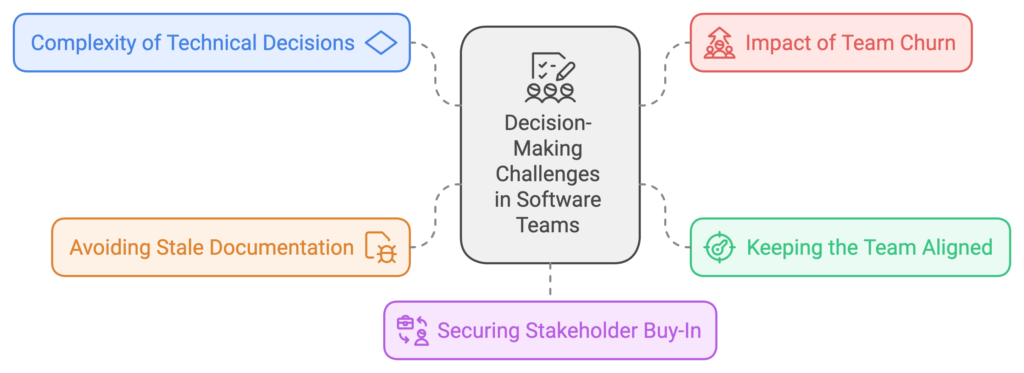Navigating Decision-Making Challenges in Software Teams
In fast-paced software development teams, poor decision-making or ineffective communication can significantly slow progress. Let’s explore the key challenges tech leads face when making and sharing decisions, focusing on quality decision-making, clear communication, and stakeholder engagement.

The Complexity of Technical Decisions
Tech leads often need to make high-stakes decisions, such as choosing the right architecture or defining technical strategies. These decisions involve complex trade-offs, and the best option isn’t always clear. Suboptimal decisions can occur when tech leads fail to thoroughly evaluate available options or make rushed choices. To avoid this, tech leads need a structured approach that considers multiple alternatives and evaluates both short-term and long-term impacts.
Impact of Team Churn on Continuity
Frequent team changes make it difficult to maintain continuity in decision-making. New members may not understand the rationale behind past decisions, leading to confusion or repeated mistakes. Documenting not only what decisions were made but also why they were made helps new members integrate smoothly and maintain team continuity, reducing inefficiencies and friction.
Keeping the Team Aligned
Effectively communicating decisions within the team can be challenging. Poor communication often results in misunderstandings or misalignment. Good documentation should be concise, accessible, and regularly updated. It must clearly explain decisions, their context, and the rationale behind them to ensure transparency and shared understanding among team members.
Avoiding the Pitfalls of Stale Documentation
Outdated documentation can be more harmful than having no documentation at all. If team members rely on old information, they may implement deprecated solutions, leading to wasted work and delays. Keeping documentation clear, current, and relevant helps prevent mistakes and ensures everyone is aligned with the correct strategies.
Securing Stakeholder Buy-In
Communicating decisions to external stakeholders, such as business leaders or other teams, is crucial. Technical decisions can impact business goals or workflows in other departments. If stakeholders do not understand the rationale behind decisions, they are less likely to support them, leading to misalignment and friction. Engaging stakeholders early and explaining decisions clearly helps ensure alignment and reduces misunderstandings.
Conclusion
Teams face many challenges when it comes to making and communicating decisions effectively. From maintaining continuity amid team changes to securing stakeholder buy-in, these hurdles require proactive solutions. Techniques like Architecture Decision Records (ADRs) offer a lightweight way to capture and communicate decisions. By addressing these challenges head-on, teams can improve decision-making, foster alignment, and achieve better results.
How does your team approach decision-making? Are there areas where better structure or communication could lead to improved outcomes? We’d love to hear your thoughts.
Subscribe to the Next Iteration Newsletter to get members only content and insights directly in your inbox!
